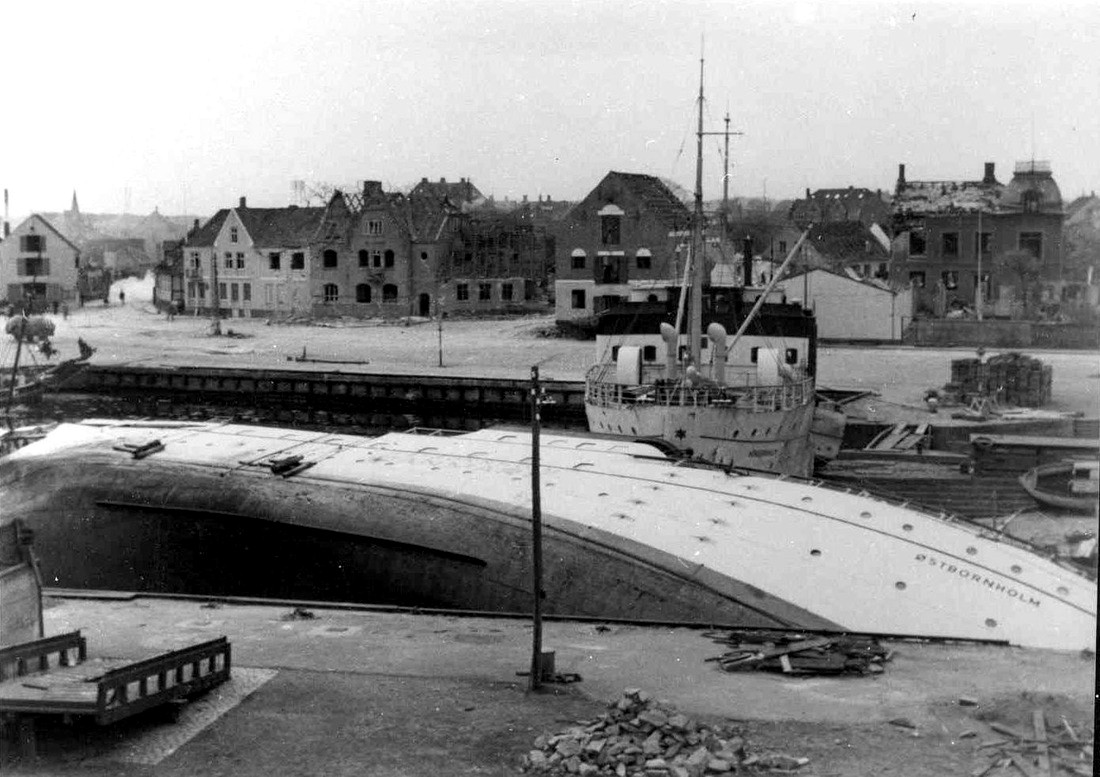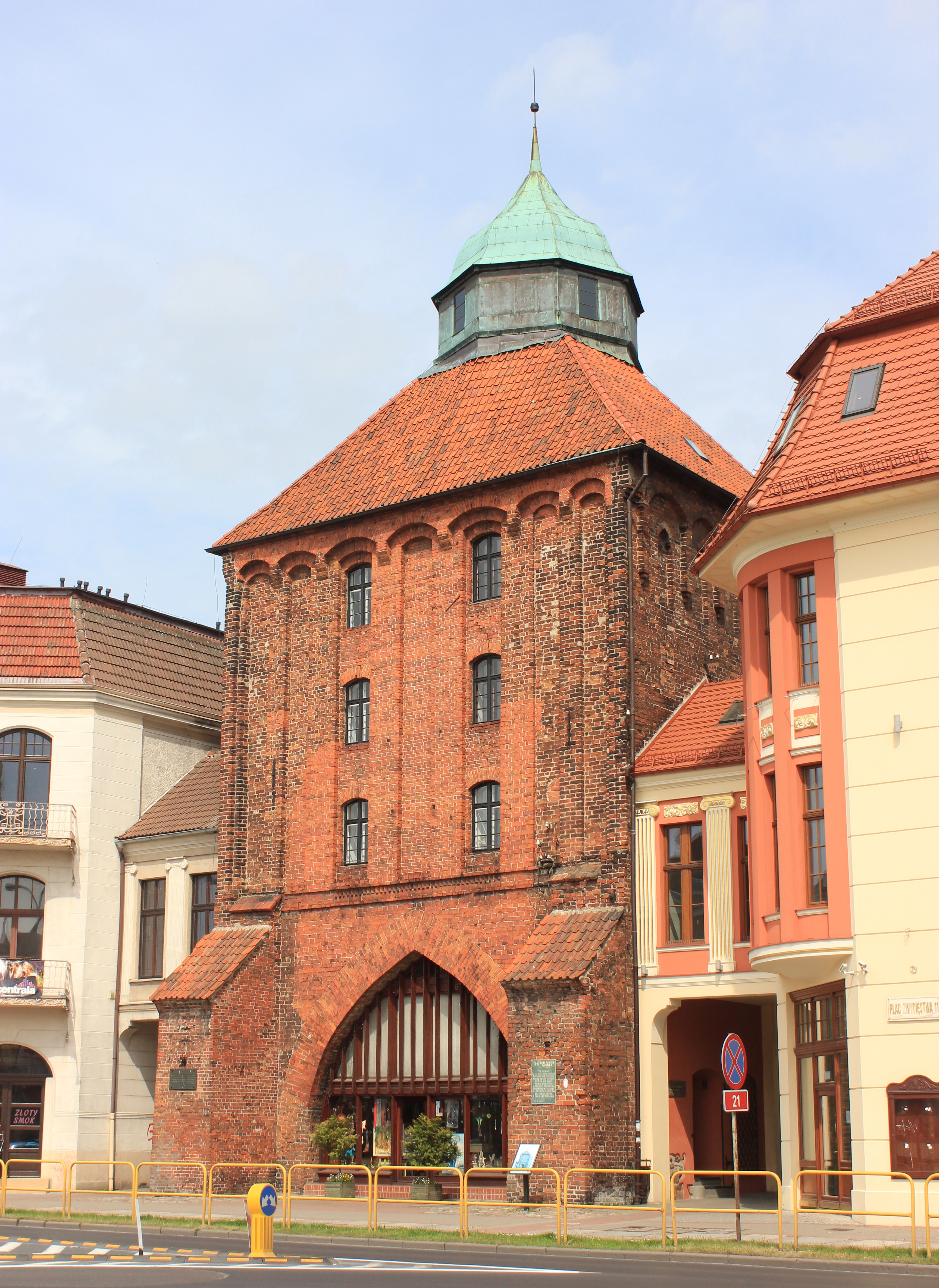|
Darłówko
Darłówko (german: Rügenwaldermünde) is a seaside neighborhood and a popular summertime resort in the town of Darłowo on the southern coast of the Baltic Sea in northern Poland. It is the site of a yearly gathering of old military vehicles, the largest of its kind in Europe, held at the end of Słowiańska street. Darłówko has two beaches, east and west, extending from either side of the Wieprza river mouth. Lighthouse Located here is the shortest lighthouse on the Polish seacoast, at 21m in height. It is administered by the marine office in Słupsk. Boat to Bornholm Until 29 August each year there is a connection by ship with Nexø on the Danish island of Bornholm. The catamaran "Jantar" carries 288 passengers, and caters mostly to the children from the summer camps nearby and from around the port of Ustka, which does not have a similar connection to Bornholm. Water park Jan "Park Wodny Jan" is a water park located at the end of Słowiańska street. See also * Darłowo ... [...More Info...] [...Related Items...] OR: [Wikipedia] [Google] [Baidu] |
Darłowo
Darłowo (Polish pronunciation: ; ; ), in full The Royal City of Darłowo ( pl, Królewskie Miasto Darłowo), is a seaside town in the West Pomeranian Region, at the south coast of the Baltic Sea, north-western Poland, with 13,324 inhabitants as of December 2021. It is located in Sławno County in West Pomeranian Voivodeship. The earliest archaeological signs of a settlement in the area occurred when Roman merchants travelled along the Amber Road in the hope of trading precious metals like bronze and silver for amber. By the 11th century the location of the later town was already becoming a significant trading point. The settlement received its town rights in 1312. Over the years Dukes of Pomerania constructed a Ducal Castle called Dirlow on a nearby island and chose it as their seat. It was here that the largest artillery piece in the world, Schwerer Gustav, was constructed and tested by Nazi Germany during World War II. The original medieval outline of Darłowo, based on th ... [...More Info...] [...Related Items...] OR: [Wikipedia] [Google] [Baidu] |
Darłowo Most Rozsuwany
Darłowo (Polish pronunciation: ; ; ), in full The Royal City of Darłowo ( pl, Królewskie Miasto Darłowo), is a seaside town in the West Pomeranian Region, at the south coast of the Baltic Sea, north-western Poland, with 13,324 inhabitants as of December 2021. It is located in Sławno County in West Pomeranian Voivodeship. The earliest archaeological signs of a settlement in the area occurred when Roman merchants travelled along the Amber Road in the hope of trading precious metals like bronze and silver for amber. By the 11th century the location of the later town was already becoming a significant trading point. The settlement received its town rights in 1312. Over the years Dukes of Pomerania constructed a Ducal Castle called Dirlow on a nearby island and chose it as their seat. It was here that the largest artillery piece in the world, Schwerer Gustav, was constructed and tested by Nazi Germany during World War II. The original medieval outline of Darłowo, based on th ... [...More Info...] [...Related Items...] OR: [Wikipedia] [Google] [Baidu] |
Wieprza
Wieprza (german: Wipper) is a river in north-western Poland in the region of Pomerania, a tributary of the Baltic Sea, with a length of and a basin area of . Towns * Kępice * Sławno * Darłowo See also *Rivers of Poland *List of rivers of Europe This article lists the principal rivers of Europe with their main tributaries. Scope The border of Europe and Asia is here defined as from the Kara Sea, along the Ural Mountains and Ural River to the Caspian Sea. While the crest of the Caucas ... 1Wieprza Rivers of Poland Rivers of West Pomeranian Voivodeship Rivers of Pomeranian Voivodeship {{Poland-river-stub ... [...More Info...] [...Related Items...] OR: [Wikipedia] [Google] [Baidu] |
Nexø
Nexø, sometimes spelled Neksø ( sv, Nexö), is a town on the east coast of the Baltic island of Bornholm, Denmark. With a population of 3,668 (as of 1 January 2022), it is the second largest town, as well as the largest fishing port on the island. Fishing was previously the mainstay of the town's economy. Nexø is also the site of a distillery (Bornholmske Spiritfabrik ApS) and a mustard factory (Bornholmersennep ApS). The town is also a port of call for the passenger ferries linking Bornholm with Kołobrzeg in Poland. Dueodde, the largest beach on Bornholm, is located south of Nexø, in the southeastern corner of the island. Etymology "Nexø" is possibly a combination of the Old Norse elements "nøkke", meaning Nix or water spirit, and "sæ" (sea). It was first documented in 1346 as ''Nexe''. [...More Info...] [...Related Items...] OR: [Wikipedia] [Google] [Baidu] |
Ustka
Ustka (pronounced ; csb, Ùskô; german: Stolpmünde) is a spa town in the Middle Pomerania region of northern Poland with 17,100 inhabitants (2001). It is part of Słupsk County in Pomeranian Voivodeship. It is located on the Slovincian Coast on the Baltic Sea. It is a port town and popular summer seaside resort of Poland. History The first settlers arrived at present-day Ustka as early as the 9th century, and established a fishing settlement with the original name of Ujść.Alicja Deck-Partyka, Poland, a Unique Country & Its People'' Authorhouse - 2006, p. 135. Accessed 2008-29-04. In the 10th century, it became part of the emerging country of Poland under its first ruler Mieszko I. The first historic records mention the village of Ujść or Ujście in 1310. The area at the mouth of the river Słupia was ceded to the nearby city of Słupsk in 1337 with the purpose of building a fishing harbour and a commercial port there to the Baltic Sea. According to documents in 1355 a chu ... [...More Info...] [...Related Items...] OR: [Wikipedia] [Google] [Baidu] |
Bornholm
Bornholm () is a Danish island in the Baltic Sea, to the east of the rest of Denmark, south of Sweden, northeast of Germany and north of Poland. Strategically located, Bornholm has been fought over for centuries. It has usually been ruled by Denmark, but also by Sweden and by Lübeck. The ruin of Hammershus, at the northwestern tip of the island, is the largest medieval fortress in northern Europe, testament to the importance of its location. Bornholm and Ertholmene comprise the last remaining Danish territory in Skåneland east of Øresund, having been surrendered to Sweden in 1658, but regained by Denmark in 1660 after a local revolt. The island is known as ("sunshine island") because of its weather and ("rock island") because of its geology, which consists of granite, except along the southern coast. The heat from the summer is stored in the rock formations and the weather is quite warm until October. As a result of the climate, a local variety of the common fig, known ... [...More Info...] [...Related Items...] OR: [Wikipedia] [Google] [Baidu] |
Denmark
) , song = ( en, "King Christian stood by the lofty mast") , song_type = National and royal anthem , image_map = EU-Denmark.svg , map_caption = , subdivision_type = Sovereign state , subdivision_name = Danish Realm, Kingdom of Denmark , established_title = History of Denmark#Middle ages, Consolidation , established_date = 8th century , established_title2 = Christianization , established_date2 = 965 , established_title3 = , established_date3 = 5 June 1849 , established_title4 = Faroese home rule , established_date4 = 24 March 1948 , established_title5 = European Economic Community, EEC 1973 enlargement of the European Communities, accession , established_date5 = 1 January 1973 , established_title6 = Greenlandic home rule , established_date6 = 1 May 1979 , official_languages = Danish language, Danish , languages_type = Regional languages , languages_sub = yes , languages = German language, GermanGerman is recognised as a protected minority language in t ... [...More Info...] [...Related Items...] OR: [Wikipedia] [Google] [Baidu] |
River Mouth
A river mouth is where a river flows into a larger body of water, such as another river, a lake/reservoir, a bay/gulf, a sea, or an ocean. At the river mouth, sediments are often deposited due to the slowing of the current reducing the carrying capacity of the water. The water from a river can enter the receiving body in a variety of different ways. The motion of a river is influenced by the relative density of the river compared to the receiving water, the rotation of the earth, and any ambient motion in the receiving water, such as tides or seiches. If the river water has a higher density than the surface of the receiving water, the river water will plunge below the surface. The river water will then either form an underflow or an interflow within the lake. However, if the river water is lighter than the receiving water, as is typically the case when fresh river water flows into the sea, the river water will float along the surface of the receiving water as an overflow. Alon ... [...More Info...] [...Related Items...] OR: [Wikipedia] [Google] [Baidu] |
Słupsk
Słupsk (; , ; formerly german: Stolp, ; also known by several alternative names) is a city with powiat rights located on the Słupia River in the Pomeranian Voivodeship in northern Poland, in the historical region of Pomerania or more specifically in its part known in contemporary Poland as Central Pomerania (''Pomorze Środkowe'') within the wider West Pomerania (''Pomorze Zachodnie''), while in Germany the corresponding area is known as East Pomerania (''Ostpommern'') within the wider Farther Pomerania (''Hinterpommern''). According to Statistics Poland, it has a population of 88,835 inhabitants while occupying , thus being one of the most densely populated cities in the country as of December 2021 . In addition, the city is the administrative seat of Słupsk County and the rural Gmina Słupsk, despite belonging to neither, while until 1999 it was the capital of Słupsk Voivodeship. Słupsk had its origins as a Pomeranian settlement in the early Middle Ages. In 1265 it was ... [...More Info...] [...Related Items...] OR: [Wikipedia] [Google] [Baidu] |



